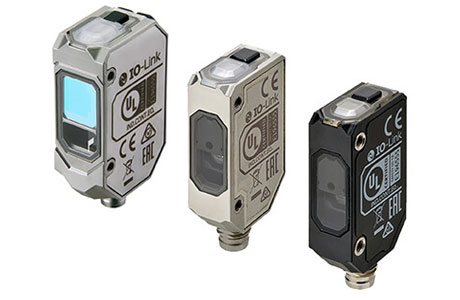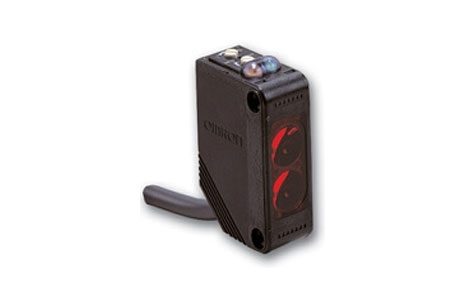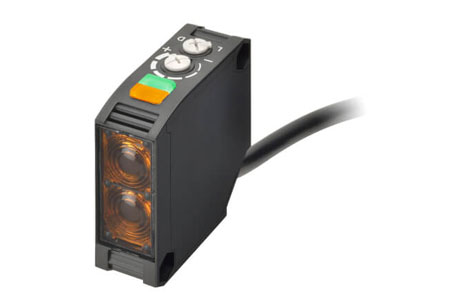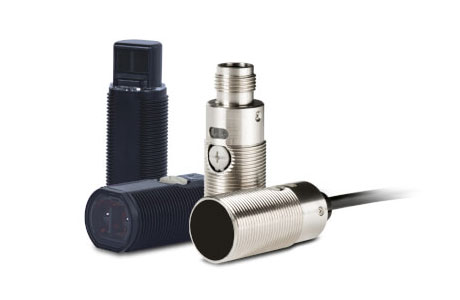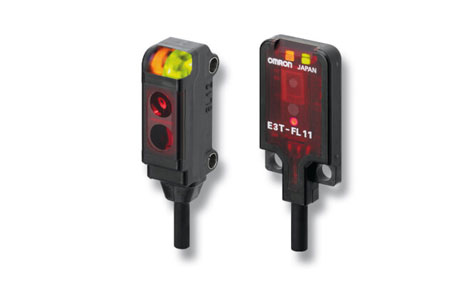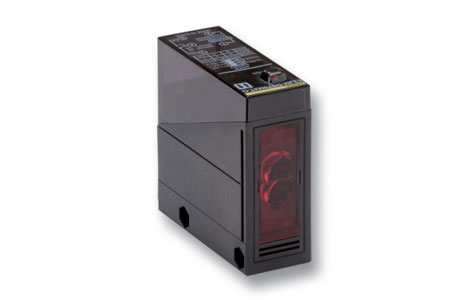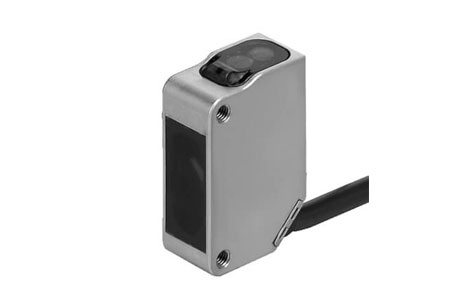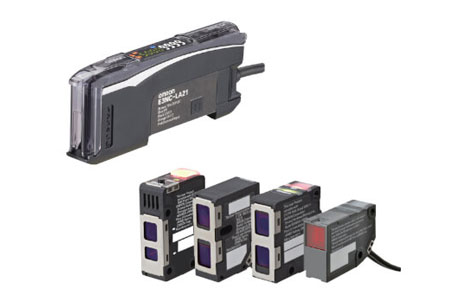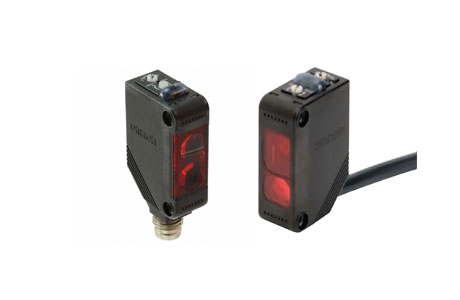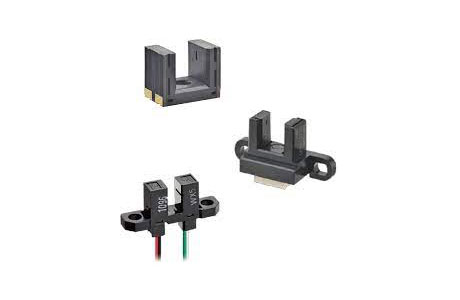
Omron Photoelectric Sensors: Photo Switches
Are you looking for Omron Photoelectric Sensors? IndMALL offers all range of Omron photoelectric switches including Omron Diffuse Photo Sensor and Omron Reflective photoelectric sensor with reflector, Through Beam Sensors etc., And we can assure Omron photoelectric sensor prices are better than Authorized Omron Photo Sensor Distributors, or Omron Dealers in Chennai, Bangalore, Hyderabad, And PAN India.
Whether you’re looking for affordability with the best Omron photoelectric sensor price or require specialized features like a miniature design, explore the world of Omron photoelectric technology right here.
Omron Photoelectric Sensors: E3AS Series
- Sensing Distance: Up to 1,500 mm.
- Response Time: As low as 1.5 ms.
- Material: Stainless steel or PBT.
- Light Type: Laser diode (infrared or red).
- Power Supply: 10-30 V.
- Output Types: NPN, PNP, IO-Link.
- Protection: IP67, IP67G, and IP69K for some models.
Omron Photoelectric Sensor E3Z
- Compact Housing: Designed for excellent performance-size ratio.
- Sensing Distance: Up to 1,000 mm; Response Time: 1 ms.
- Housing Material: PBT (Polybutylene terephthalate).
- Light Type: Infrared and red LED options.
- Power Supply Voltage: 12-24 V; Operation Mode: Dark-ON, Light-ON.
- Output Types: NPN and PNP, with some models offering IO-Link.
- Protection: IP67 and IP69K for high water resistance.
Omron Photoelectric Switch: E3ZM Series
- Housing: High-grade stainless steel (SUS316L).
- Sensing Distance: Up to 1,000 mm; Response Time: 1 ms.
- Light Type: Infrared and red LED options.
- Power Supply Voltage: 10-30 V.
- Output Types: NPN and PNP; Operation Mode: Dark-ON, Light-ON.
- Protection: IP67 and IP69K for high water resistance.
Omron Photoelectric Sensor E3JK
- Voltage Range: 24 to 240 VAC.
- Output Types: Models with PNP/NPN transistor output and relay output.
- Sensing Distance: Up to 2,500 mm for diffuse reflective models; up to 11,000 mm for retro-reflective models; up to 40,000 mm for through-beam models.
- Response Time: 1 ms for transistor output models, 20 ms for relay output models.
- Light Type: Red LED and infrared LED options.
- Housing Material: ABS; Protection: IP64.
Omron Photoelectric Sensor E3FA/E3FB
- Sensing Methods: Diffuse reflective, retro-reflective, and background suppression.
- Sensing Distance: Up to 1,000 mm for diffuse reflective, 4,000 mm for retro-reflective, and up to 500 mm for coaxial retro-reflective.
- Response Time: 0.5 ms; Thread Size: M18.
- Housing Material: ABS, cylindrical axial shape.
- Light Type: Polarity-free red light and infrared light.
- Power Supply Voltage: 10-30 V; Output Types: NPN and PNP.
- Protection: IP67/IP69K.
Omron Miniature Photoelectric Sensor: E3T Series
- Housing: Miniature plastic, cuboid shape with M2 or M3 mounting.
- Sensing Methods: Diffuse reflective, background suppression, through-beam, limited reflective, retro-reflective.
- Sensing Distance: Varies by model, up to 1,000 mm for through-beam models.
- Response Time: 1 ms; Material Housing: PBT.
- Light Type: Polarity free red light.
- Power Supply Voltage: 12-24 V; Output Types: NPN and PNP.
- Protection: IP67 for selected models.
Omron Photo Sensor: E3JM Series
- Voltage: 12-240 VDC, 24-240 VAC.
- Output: Relay or solid-state relay.
- Sensing Distance: Up to 10,000 mm (through-beam), 700 mm (diffuse reflective), 4,000 mm (retro-reflective).
- Response Time: 30 ms (relay), 5 ms (PNP).
- Housing: ABS, cuboid shape.
- Light Type: Infrared, polarized red light; Protection: IP66 for certain models.
Omron Retro reflective Sensor: E3ZM-B Series
- Sensing Method: Retro-reflective; Sensing Distance: Up to 500 mm.
- Response Time: 1 ms.
- Housing Material: Stainless steel.
- Light Type: Polarized red light.
- Power Supply Voltage: 10-30 V; Output Type: NPN and PNP.
- Operation Mode: Dark-ON, Light-ON.
Omron Through Beam Photoelectric Sensor: E3ZM-C Series
- Sensing Distance: Up to 20,000 mm (through-beam), 1,000 mm (diffuse/retro-reflective), 100-200 mm (limited reflective).
- Response Time: 1-2 ms; Housing: Stainless steel.
- Light Types: Infrared, red, orange LED.
- Voltage: 10-30 V; Output: NPN, PNP.
- Protection: IP67, IP69K.
- Features: Oil-resistant, high visibility LED (through-beam).
Omron Diffuse Reflective Photo Sensor: E3NC Series
- Sensing Distance: Up to 1.2 m for diffuse-reflective, 70±15 mm for limited reflective, and 8 m for coaxial retro-reflective.
- Light Source: Red laser diode.
- Beam Size: Varies by model, as small as 0.1 mm.
- Protection: IP67 for some models, IP65 for others.
- Response Time: Ranges from 80 µs to 16 ms depending on mode.
- Supply Voltage: 10 to 30 VDC; Output Types: NPN and PNP.
Omron Photo Electric Sensor: E3Z-LS Series
- Sensing Method: Distance-settable.
- Output Types: NPN and PNP; Sensing Distance: Up to 200 mm.
- Light Source: Red LED; Voltage: 12 to 24 VDC.
- Response Time: 1 ms max.
- Protection: IP67; Material: PBT case, polyarylate lens.
- Connection: Pre-wired or M8 connector.
Omron Photomicro Sensor: EE Series
- Sensing Method: Through-beam, various types (Slot, Reflective, Limited-reflective, Diffuse-reflective, Retro-reflective).
- Sensing Distance: 5 mm; Connection: System connector.
- Output: NPN, PNP; Voltage: 5-24 V.
- Operation Modes: Dark-ON, Light-ON.
- Response Time: 0.17 ms; Material: PBT.
- Light Type: Infrared; Dimensions: Varies by shape (Straight, T-shaped).
Omron provides a variety of photoelectric sensors for touch-free object detection. Their compact miniature sensor fits tight spaces. The through-beam sensor detects objects interrupting its light beam quickly, while the diffuse sensor is ideal for close or uneven objects. The retro-reflective sensor, using a reflector, identifies transparent objects or those in complex setups.
Widely trusted in industries like packaging and food production, their range includes Omron Photoelectric Sensors, Diffuse Photo Sensors, and Photoelectric Switch. Popular models such as Omron Sensor E3Z, E3JK, and E3FA are available at competitive prices.
People Also Ask
What are the three types of photoelectric sensors?
There are 3 Types of Photoelectric Sensors are there
- Through Beam Photoelectric Sensors
- Retro Reflective Photoelectric Sensors
- Diffuse Photoelectric Sensors
Thru Beam Photo Sensor: It has Emitter & Receiver Seperatly. Continuously emitter will emit the light and the receiver will receive the light. When an object passes through the beam light the receiver won’t receive the light from Emitter, then Receiver will send the Output signal to the controllers.
Reflective Photo Sensor: It has an emitter & Receiver in one device. Same as thru beam sensor emitter will emit the light and the receiver will receive the light, But here is there a difference here we need to use one reflector separately. We should place the device on one side exact opposite side we need to place the Reflector. the emitter will emit the light, and that light through the reflector will reflect and receives by the Receiver. When an object interrupts the light receiver won’t receive the signal then the receiver will send the output signal to the Controller.
Diffuse Photo Sensor: Same as Reflective Photoelectric Sensor, Emitter & Receiver in one device but there is no Reflector required. The emitter will emit the light when the object passes opposite to the Sensor device light will reflect and reflected light will receive to the Receivers. Then Receiver will send the output signal to the Controllers.
Sensing Distance:
Thru Beam Photo Sensor (20+Meters ) >> Reflective Photo Sensor (1-5 Meters) >> Diffuse Photo Sensor (100mm to 1Meter)
Now it’s your time to decide which sensor is suitable for you.
What does OMRON photoelectric sensor do?
These sensors can be configured with adjustable distances and may feature built-in or separate amplifiers, along with fiber optic units. This flexibility makes them suitable for diverse applications in detecting the presence and position of objects in automated setups.
What is photoelectric sensors used for?
Photoelectric Sensors are regularly used to detect the object’s presence or Absence by using a light transmitter. Based on your application you should select the Thru Beam Photo sensor, Reflective Photo Sensor, and Diffuse Photo Sensor.
What is the range of photoelectric sensor?
As you know there 3 types of Photo Sensors that is Thru Beam, Reflective Type, and Diffuse Sensor.
- Thru Beam Photoelectric Sensor based on different brands Sensing distance will come from 1 Meter to 20+ Meters.
- Retro Reflective Photoelectric Sensor based on different brands Sensing distance will come from 500 mm to 5+ Meters.
- Diffuse Photoelectric Sensor based on different brands Sensing distance will come from 200mm to 1+ Meters.
Which type of photoelectric sensor has the longest range?
In Simple Answer is Through Beam Photoelectric Sensors. Sensing distance from 1 Meter to 20+ Meters. It’s available in Rectangular types & Cylindrical Photo sensors. Here is a there better thing, you can use 10 Meter sensor for 5 Meter purposes which means the Sensing Distance can adjust. For more sensors in diffuse type sensors then you go for Distance Sensor.
Distance Sensors available in Pepperl Fuchs, Leuze etc.,
Can photoelectric sensors detect plastic?
Yes, a Photoelectric sensor can detect any object including Plastic, Metal, Wood, Rubber, Glass, Liquid etc., Photo Sensor’s main job is to check the object presence & absence of any object. If an object passes through Photo Sensor it will give an indication to the controller.
How to Select the Photoelectric Sensor?
When you want to purchase any Photoelectric sensors you should be very clear about these technical details. Through-beam Photoelectric sensors will have Emitter & Receiver Seperatly. The emitter will emit the signal Receiver will receive the signal when any object crosses the light between Emitter & Receiver, then Receiver will give a signal to the controller. Whenever you are purchasing Through-beam Photoelectric sensor you should know how much sensing distance we required generally it will come in Meters, What is the output you want like PNP, NPN, etc., Cable Type or Connector Type, Light On/Dark On, Light Infrared or RED Light, etc.,
Retro-reflective Photoelectric sensors will have Emitter & Receiver in one Device And Seperatly Reflector we need to purchase, Same Principle for retro-reflective, Emitter emits the light we need to keep the reflector in opposite direction emitted light will reflect through the Reflector and it will receive to the Receiver. When any object crosses the signal Receiver won’t get a signal then Receiver will send the signal/output to the controllers. Same As Through-beam photo Sensors we must know how much sensing distance we need, Output: PNP, NPN; Cable or Connector Type, etc.,
Diffuse Photoelectric sensor will have Emitter & Receiver in the Same device, Any separate reflector is not required. Diffuse reflective Photo Sensor The emitter will emit light when an object came that light reflects through an object and that light/Signal will receive by the Receiver. Same as Thru Beam Photoelectric sensor & Retro reflective Photoelectric sensor we need to select a Diffuse Photo Sensor But here we need to check Background Suppression is it required, the Remaining Sensing distance, Output, Cable or Connector type.
Photoelectric Sensor Working Principle
A photoelectric sensor works by emitting a light beam (visible or infrared) from its light source. When an object interrupts this beam, the sensor detects the change in light intensity. The sensor then triggers a response, such as a signal output, to indicate the presence or absence of the object.
For your Omron Photoelectric Sensors requirements in Chennai, get a quote now.

